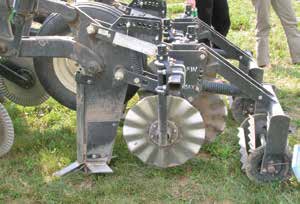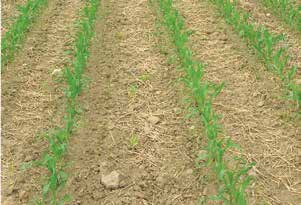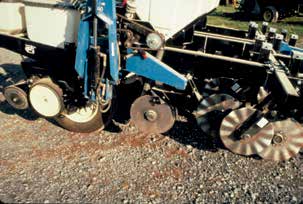chAPter 16 reduCing tillage
Table 16.2
The Effect of 32 Years of Plow and No Tillage under
Organic No Till?
Corn Production on Selected Soil Health Indicators
Researchers at the Rodale Institute in Pennsylvania have developed
Soil Health Indicator
Plow-Tillage No-Tillage
innovative cover crop management equipment that facilitates
growing row crops in a no-till system. An annual or winter
Physical
annual cover crop is rolled down with a special y designed, front-
Aggregate stability (%)
22
50
mounted, heavy roller-crimper, resulting in a weed-suppressing
mat through which it is possible to plant or drill seeds (figure 16.7)
*Bulk density (g/cm3)
1.39
1.32
or set transplants. For this system to work best sufficient time
*Penetration resistance (psi)
140
156
must be al owed for the cover crop to grow large before rolling-
crimping, so that the mulch can do a good job of suppressing
Permeability (mm/hr)
2.1
2.4
weeds. Cover crops must have gone through the early stages of
Plant-available water capacity (%)
29.1
35.7
reproduction in order for the roller-crimper to kill them, but not
be fully matured to avoid viable seeds that could become weeds
Infiltration capacity (mm/hr)
1.58
1.63
in the following crop. Since timing of any farm operation is critical,
Chemical
careful attention to the details of these biological y based systems
Early-season nitrate-N (lbs/ac)
13
20
is needed for them to be successful.
Phosphorus (lbs/ac)
20
21
Potassium (lbs/ac)
88
95
Magnesium (lbs/ac)
310
414
Calcium (lbs/ac)
7,172
7,152
*pH
8.0
7.8
Biological
Organic matter (%)
4.0
5.4
Cellulose decomposition rate (%/week)
3.0
8.9
Potential y mineralizable nitrogen
(μg/g/week)
1.5
1.7
Easily extractable glomalin (mg/g soil)
1.2
1.7
Total glomalin (mg/g soil)
4.3
6.6
Figure 16.7. Roller-crimper creates a weed-suppressing cover-crop
Note: Higher values indicate better health, except for those listed with mat through which it is possible to plant seeds or transplants. Here
an asterisk, for which lower values are better.
cotton is being planted behind rye that has been traveled over by
Source: Moebius et al. (2008).
the roller-crimper. Photo by Jeff Mitchell.
tillage systems. One of the reasons for this is the lower
management and use intermediate tillage methods, as
availability of N in the early years of no-till. Knowing
described in the next sections.
this allows you to compensate by adding increased N
With the absence of tillage, seed placement, compac-
(legumes, manures, fertilizers) during the transition
tion prevention, and weed control become more critical.
years. It takes a few years for no-tilled soils to improve,
No-till planters and drills (figure 16.6) are advanced
after which they typically out-yield conventionally tilled
pieces of engineering that need to be rugged and adapt-
soils. The transition can be challenging because a radical
able to different soil conditions yet be able to place a
move from conventional to no tillage can create failures
seed precisely at a specified depth. The technology has
if the soil was previously degraded and compacted. It
come a long way since Jethro Tull’s early seeders, espe-
is best to first build degraded soils with organic matter
cially in the past decades when no-till seeders have been
180
Building SoilS for Better CropS: SuStainaBle Soil ManageMent









